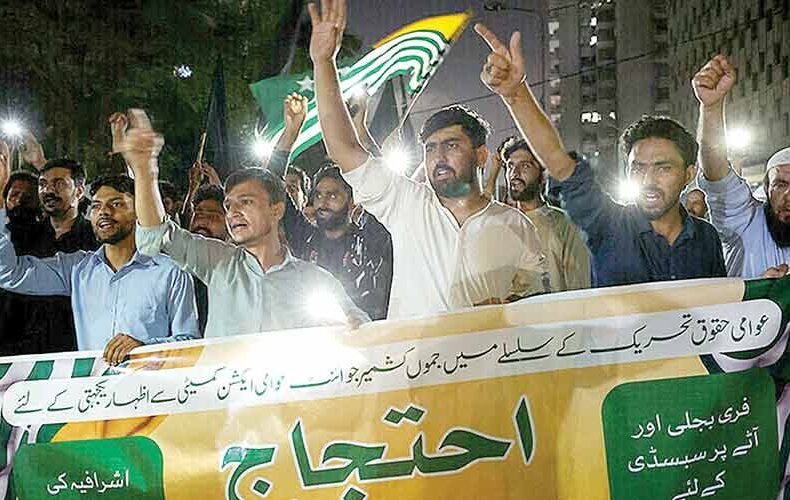
Addressing grassroots anxieties
**Landmark Agreement Brings Temporary Calm to Azad Jammu and Kashmir Amidst Protests**
In a pivotal development for Azad Jammu and Kashmir (AJK), the government of Pakistan and the Jammu and Kashmir Joint Awami Action Committee (JAAC) signed a landmark agreement on October 4, ending six days of violent protests that had claimed at least 10 lives and left dozens injured.
Described by Prime Minister Shahbaz Sharif as a resolution that “buried the conspiracies,” the deal seeks to address long-standing grievances related to economic hardship and governance failures. Whether this agreement marks a true turning point or merely postpones a satisfactory resolution hinges entirely on its implementation.
### Details of the Agreement
Following two rounds of talks, a delegation led by Planning Minister Ahsan Iqbal, and including Kashmir Affairs Minister Amir Muqam and PPP leader Qamar Zaman Kaira, announced a 15-day mechanism to meet key demands.
Key components of the agreement include:
– Compensation for those killed in the violence, matching the amount given to security personnel.
– Rs 1 million compensation for individuals injured in the gunfire.
– A government job for one family member of each deceased protester, with appointments to be made within 20 days.
– Registration of cases under the Anti-Terrorism Act for acts of political violence.
– Formation of judicial commissions where appropriate.
### The Unrest That Shook Azad Jammu and Kashmir
The unrest that paralyzed the region began on September 29, when the JAAC mobilized thousands of people across Azad Jammu and Kashmir. Led by Sardar Omer Nazir, Raja Amjad, Shaukat Nawaz Mir, and Anjum Zaman Awan, the committee presented a 38-point charter of demands. These demands ranged from free education and healthcare to major infrastructure projects.
At the heart of the movement were two deeply political issues:
– The discontinuation of elite privileges for top officials.
– The abolition of 12 legislative assembly seats reserved for refugees from Indian-administered Kashmir—seats which JAAC leaders argue have monopolized development funds and political power.
What began as a largely peaceful strike in support of these activists quickly deteriorated into street violence. On October 1 and 2, clashes between rival protesters and police in Muzaffarabad and Dhirkot turned deadly, with gunfire and the use of teargas leaving at least 10 people dead and dozens injured.
The JAAC condemned the deployment of Pakistan Rangers as unnecessary and unhelpful. The Human Rights Commission of Pakistan criticized the use of excessive force and denounced the subsequent information blackout. Meanwhile, pro-government rallies accused JAAC activism of being part of a foreign-backed conspiracy, deepening mistrust and polarization.
### A Pattern of Mobilization and Political Challenge
This latest wave of mobilization is neither spontaneous nor isolated. It marks the third major uprising in AJK in just two years and reflects a widening rift between the people and the government.
– In May 2024, widespread protests over electricity tariffs, taxation, and resource distribution forced the government to pledge reforms and a judicial review of elite privileges.
– In December 2023, JAAC led another region-wide campaign against the Peaceful Assembly and Public Order Ordinance, which sought to criminalize active dissent. Sustained pressure eventually forced authorities to dilute key provisions of the ordinance.
This sustained pattern of mobilization has transformed public discontent into a broad political movement. What began as issue-specific demonstrations has evolved into a challenge to the power dynamics between AJK and Islamabad.
The JAAC now cuts across party lines and socio-economic divides, uniting citizens around narratives of dignity, accountability, and democratic participation.
### Structural Issues Underlying the Crisis
At its core, the current unrest is part of a reckoning with decades of unresponsive governance. The JAAC has transformed from a pressure group into a decisive political actor capable of shaping state-society relations in the region.
A central driver of this mobilization is the government’s repeated failure to deliver on its promises. Successive leaders have announced reforms only to abandon or dilute them once public pressure subsides. This persistent gap between rhetoric and reality has eroded public trust and deepened the conviction that official institutions are unwilling or unable to address citizens’ concerns.
Beneath the immediate crisis lies a deep structural flaw in AJK’s political order. Despite having its own institutions, the region’s administration functions largely as an extension of the government in Islamabad rather than being truly representative.
Major decisions on resource allocation, development priorities, and governance are often taken in Islamabad with little input from local stakeholders. This over-centralization has weakened democratic accountability and entrenched political dependency.
Moreover, the exclusion of local voices from policymaking has compounded the problem. Policies and projects affecting communities are frequently conceived without meaningful consultation, resulting in poor outcomes and reinforcing the perception that the people of AJK are governed rather than represented.
### The Way Forward: From Stopgap Measures to Structural Reform
Until these structural imbalances are addressed, periodic protests are likely to persist, with each wave stronger than the last.
Treating grassroots dissent as a security threat or dismissing it as a foreign conspiracy may offer short-term political cover, but it does nothing to solve the underlying inequities driving public anger. Instead, such tactics deepen mistrust and push the region further from stability.
At its heart, the JAAC movement is about far more than subsidies and infrastructure. It reflects a long-simmering demand for dignity, accountability, and meaningful representation—demands that have gone unmet for decades.
Unless these root causes are addressed, the 15-day mechanism and compensation packages will remain mere stopgap measures.
The stakes are higher than ever before. Addressing the crisis in AJK requires more than short-term firefighting; it demands a fundamental rethinking of governance in the region.
If ignored, growing public pressure could inspire similar movements elsewhere. Coercion can suppress dissent temporarily, but only genuine governance can resolve it.
—
*This article highlights the complexities surrounding the recent unrest in Azad Jammu and Kashmir and the significance of the agreement between JAAC and the government of Pakistan. Sustainable peace and progress depend on political will and structural reforms that prioritise the rights and voices of AJK’s people.*
https://www.thenews.com.pk/tns/detail/1350029-addressing-grassroots-anxieties
You may also like
You may be interested
Guns and butter: Russia chooses both
A required part of this site couldn’t load. This may...
Saudi Arabia & Pakistan Ink Defence Agreement Stating ‘Attack On Either Will Be Considered Attack On Both’
**Saudi Arabia and Pakistan Sign Strategic Mutual Defence Agreement** *Riyadh:*...
Congress Leader Rahul Gandhi Says He’s ‘Getting Help From Inside ECI’ To Expose Alleged Vote Fraud – Video
New Delhi: Congress leader Rahul Gandhi has alleged that he...
 The New York Times
The New York Times
- The Tourism Slump Squeezes Navajo Nation Parks Like Monument Valley 2025 年 11 月 26 日 Gabe Castro-Root
- U.S. Nuclear Arms Chief Warns Against Leaks of Secret Information 2025 年 11 月 26 日 William J. Broad
- Britain Raises Taxes by More Than $30 Billion in Tougher Economic Outlook 2025 年 11 月 26 日 Eshe Nelson
- Trump Administration Will Raise Prices for Foreign Tourists at National Parks 2025 年 11 月 26 日 Chris Cameron
- What You’re Thankful For 2025 年 11 月 26 日 Sam Sifton
- The Question Hanging Over Peace Talks: What Will Putin Accept? 2025 年 11 月 26 日 Paul Sonne
- ‘Imperial Israel’ in the New Middle East 2025 年 11 月 26 日 Roger Cohen and David Guttenfelder
- Democrats Say F.B.I. Is Investigating Them, and U.S. Plans Gaza Compounds 2025 年 11 月 26 日 Tracy Mumford, Will Jarvis, Ian Stewart and Kate LoPresti
- Has Marjorie Taylor Greene Really Seen the Light? 2025 年 11 月 26 日 Tressie McMillan Cottom
- Fact Check: Is Trump Right About Affordability? 2025 年 11 月 26 日 Linda Qiu, Claire Hogan, Stephanie Swart and Pierre Kattar



Leave a Reply